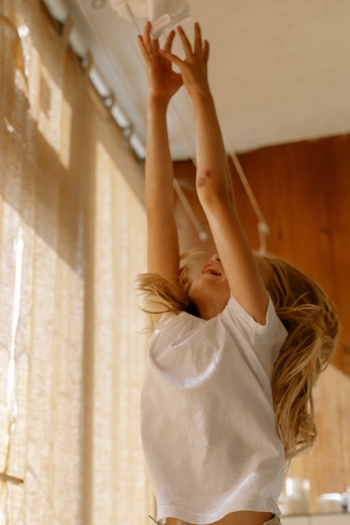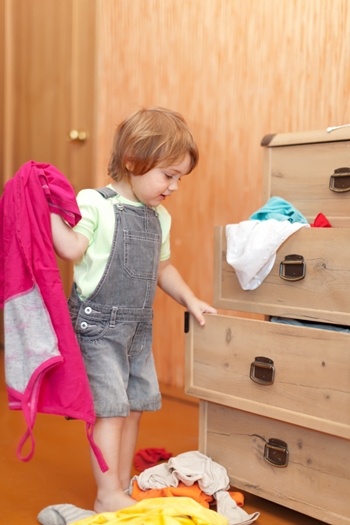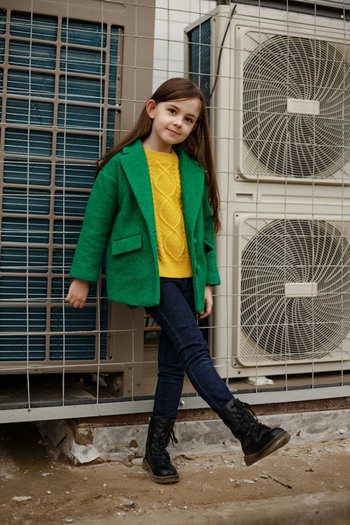Hoy, como de costumbre y como parte de la orientación que desde @Mundo.Autismo nos hemos dispuesto a ofrecer en beneficio de todos nuestros niños; dentro del espectro, con alguna condición física o sin ella, he traído 3 nuevos ejercicios relacionados con el fortalecimiento de la motricidad (gruesa y/o fina)
1.- Comenzamos con el primero de los tres, el cual va dirigido a mejorar la motricidad gruesa en niños entre 2-3 años de edad además de despertar y reforzar la imitación motora en aquellos entre 1-2 años .
Today, as usual and as part of the guidance that from @Mundo.Autismo we have been willing to offer for the benefit of all our children; within the spectrum, with any physical condition or without it, I have brought 3 new exercises related to the strengthening of motor skills (gross and/or fine).
We begin with the first of the three, which is aimed at improving gross motor skills in children between 2-3 years of age as well as awakening and reinforcing motor imitation in those between 1-2 years of age.

La meta es el fortalecimiento de los músculos de las piernas, de manera sencilla, lenta y progresiva.
El objetivo a mediano plazo saltar a manera de alcanzar un objeto suspendido una frecuencia de 10 veces.
Lo que necesitamos para esta actividad es una cuerda y un juguete de colores llamativos, paciencia, energía positiva y palabras motivadoras.
Comencemos
Recuerda que queremos motivar al niño y la mejor manera de que ocurra es que nos vea mientras lo hacemos. Saltemos al aire, llamando su atención mostrándole la forma en que puede lograrlo, las veces que sean necesarias hasta que comience a imitarnos.
Si al cabo de un tiempo prudente no intenta saltar, cambias y lo tomas por debajo de los brazos y haciendo movimientos suaves lo haces saltar contigo.
En la misma medida que sientas que comienza a impulsarse, vas reduciendo la ayuda hasta que lo haga por si mismo.
En este punto cuelgas la cuerda y el juguete que has escogido previamente (debe ser uno que realmente llame sus atención)
Cuando tengas su atención, le muestras la manera de tomarlo, (siempre que quede a su alcance) que con saltos pequeños sienta que puede tomarlo sin dejar de saltar (trata de que te imite).
Cuando comience a hacer los intentos y aunque no lo haya logrado aún elogia sus progresos y entusiasmo.
Cuenta las veces que logra tocar el juguete antes de que se canse. Al llegar a la décima vez que lo toque le subes un poco más, siempre tomando en cuenta que quede a su alcance para repetir nuevamente el proceso.
The goal is to strengthen the leg muscles in a simple, slow and progressive manner.
The medium-term objective is to jump in a way to reach a suspended object a frequency of 10 times.
What we need for this activity is a rope and a brightly colored toy, patience, positive energy and motivational words.
Let's start
Remember that we want to motivate the child and the best way to make it happen is for him to see us while we do it. Let's jump in the air, calling his attention by showing him the way he can do it, as many times as necessary until he starts imitating us.
If after a prudent time he does not try to jump, you change and take him under your arms and making smooth movements you make him jump with you.
As soon as you feel that he starts to push himself, you reduce the help until he does it by himself.
- At this point you hang the rope and the toy you have previously chosen (it must be one that really catches his attention).
- When you have his attention, you show him the way to take it, (as long as it is within his reach) and with small jumps he feels that he can take it without stopping jumping (try to make him imitate you).
When he starts to make attempts and even if he hasn't succeeded yet, praise his progress and enthusiasm.
Count the number of times he succeeds in touching the toy before he gets tired. When he reaches the tenth time that he touches it, you raise it a little more, always taking into account that it is within his reach to repeat the process again.

El objetivo a corto plazo es abrir y cerrar cajones sin ayuda por lo que necesitaremos juguetes, gavetas de ropa y cajones.
Lo primero que necesitas es su atención. Debes asegurarte que sus ojitos estén puestos en ti.
Tomarás un juguete, el que más le guste y mientras te está observando, escondes el juguete dentro de la gaveta y luego, lentamente, lo vuelves a sacar, a esconder y cierras la gaveta ante sus ojos.
Seguidamente, toma su mano y colócala en el pomo y con tu ayuda haz que tire de él, abra la gaveta, encuentre el juguete, lo tenga en su mano y después de unos minutos lo vuelves a esconder en ella y repites el procedimiento hasta que veas que logra abrirla por sí mismo.
Observación Importante
Cuando empiezas estos ejercicios, recuerda que ya debes comenzar a guardar los medicamentos o sustancias peligrosas en cajones o lugares fuera de su alcance.
Al realizar estas actividades los cajones que escojas deben ser ligeros y con poca dificultad para abrirlos para evitar que haga un mal movimiento y le cause dolor, que se frustre o le haga desistir de intentarlo.
After you have reached the goal and rested for a few seconds, continue with the second exercise. This activity seeks to improve their ability to meet their own needs as well as strengthen their arms and legs.
The short-term objective is to open and close drawers without help, so we will need toys, clothes drawers and drawers.
The first thing you need is their attention. Make sure their eyes are on you.
You will take a toy, the one he likes the most and while he is watching you, hide the toy inside the drawer and then slowly take it out again, hide it and close the drawer in front of his eyes.
- Next, take his hand and place it on the knob and with your help make him pull it, open the drawer, find the toy, hold it in his hand and after a few minutes hide it again in the drawer and repeat the procedure until you see that he manages to open it by himself.
Important Observation
When you start these exercises, remember that you should start keeping medicines or dangerous substances in drawers or places out of their reach.
When performing these activities, the drawers you choose should be light and with little difficulty to open them to prevent him from making a wrong movement and causing him pain, frustration or giving up trying.

Vas a necesitar dos silla y un palo ligero como de 1 metro. Como siempre debes esperar a tener toda su atención. (Busca ayuda, si crees ncesitarla).
Coloca las dos sillas juntas en un lugar libre de objetos. Mientras te está mirando, coloca tu mano sobre la silla y apóyate en ella , poco a poco levanta un pie e instalo a que te imite. (Repite esta acción las veces que creas necesaria hasta ver que entiende la idea)
Si aún no puede hacerlo, pide a alguien que te ayude a que tome la posición adecuada sin que tu cambies la tuya, que será la que deba imitar. Repite hasta que logre hacerlo por sí mismo.
Cuando veas que ya ha conseguido hacer esta primera parte, lo tomas por sus manos y muéstrale seguridad. Poco a poco le das un extremo del palo y le pides que lo tome sin soltarse de la silla.
Lentamente y estando segura de que tiene el otro extremo seguro, alejas la silla y le instas a que se sostenga del palo. Ofrécele confianza con palabras motivadoras como "dale, tu puedes!, yo te sostengo desde este lado!, no sueltes el palo!"
Cuando sientas que ha conseguido estabilidad, quítale el palo poco a poco y haz que permanezca así por 5 segundos.
NOTA IMPORTANTE:
"No dejes de hacerle sentir bien en "CADA" acción, no importa que no consiga el objetivo lo rápido que esperas o quisieras. No es un error suyo, pero será un éxito para ambos y un motivo más para estar orgullosos por otro de sus logros cuando finalmente lo haga!!!"
And to finish for today, play! This last exercise will help you to improve your balance. The main objective is to maintain, for at least 5 seconds, your balance on one foot.
You will need two chairs and a light stick about 1 meter long. As always, wait until you have their full attention (seek help if you think you need it).
- Place the two chairs together in a place free of objects. While he is looking at you, place your hand on the chair and lean on it, slowly lift one foot and ask him to imitate you. (Repeat this action as many times as you think necessary until you see that he understands the idea).
If he still can not do it, ask someone to help him to take the right position without you changing yours, which will be the one to imitate. Repeat until he is able to do it by himself.
When you see that he has managed to do this first part, take him by his hands and show him confidence. Gradually give him one end of the stick and ask him to take it without letting go of the chair.
Slowly, and being sure that he has the other end secure, you move the chair away from him and urge him to hold on to the stick. Offer reassurance with motivating words such as "Come on, you can do it, I'll hold you from this side, don't let go of the stick!"
When you feel that he has achieved stability, take the stick away little by little and have him stay that way for 5 seconds.
IMPORTANT NOTE:
"Don't stop making him feel good in "EVERY" action, no matter if he doesn't get the target as fast as you expect or would like. It's not his mistake, but it will be a success for both of you and one more reason to be proud of another of his accomplishments when he finally does it.
"Si hay algo que una persona con autismo necesita de nosotros es Empatía. Es gratis y vas a hacer a alguien muy feliz"
Gracias por tu visita, lectura y apoyo!

Hola amiga, estoy fascinada con tus contenidos sobre este tema, te cuento, que Alan recibió diez sesiones de terapia ocupacional hace poco, terminó hace un mes. Allí le indicaron ejercicios para la motricidad gruesa y también tiene un poco de dificultad con la motricidad fina. Claro ya el está grande pero ver tu material, me ha servido para darme cuenta que Alan desde muy pequeñito recibió el estímulo en casa y en una sala de terapia integral recibió terapia ocupacional donde jugaba, hacia actividades que demandaban su atención y equilibrio, pero definitivamente ya grande se debe seguir estimulando su motricidad. No son graves las pequeñas deficiencias que tiene pero si se pueden corregir le va hacer la vida más fácil.
Mi agradecimiento y un abrazo para ti 💙
Es un verdadero gusto que haya sido de tu agrado y le hayas encontrado utilidad para llevarlos a cabo con tu niño. Yo igual los sigo en casa con los míos porque a pesar de la edad hay movimientos y posturas que aún no han madurado. Me alegra mucho y espero, que al igual que a ti, sirvan para muchos. Este taller lo recibí cuando ellos tenían 3 añitos (hace trece años ya ) y los he puesto en práctica amoldándolos a sus necesidades, en la misma medida que han ido creciendo y he querido compartir los que me han funcionado, de la manera que los he puesto en práctica.
Agradezco me hayas dado la oportunidad.
Un gran abrazo mi estimada @parauri
Excelente @esthersanchez
Esto complementa el post sobre motricidad fina.
Saludos.
Si, todo está estrechamente relacionado.
Muchísimas gracias por tu apreciación!
Hola @esthersanchez. De nuevo estamos complacidos de recibir tu contenido útil 💙
¡Bienvenidas las Delegaciones / Welcome Delegations
Trail de Curación / Curation Trail
Muchas gracias!!
Un material muy completo. Nuestro agradecimiento 💙
#posh
!hueso
Click on this banner, to be directed to the Virtual World Discord and learn more about the curation project.
Thank you! I ppreciate it!!
Felicitaciones!
Gracias por deleitarnos con tan magnífica publicación, la cual fue valorada por @Womentribe una comunidad para destacar el valioso potencial del ser humano.
*Sigue nuestras cuentas:
@Womentribe
suscribete aquí @colmena-139925
twitter
Instagram
Has sido curado por @visualblock / You've been curated by @visualblock
Bienvenidas delegaciones / Delegations welcome
Encuentra nuestra comunidad aquí / Find our community here
Trail de Curación / Curation Trail
Vota por nuestro Testigo aliado - @hispapro / Vote for our allied Witness - @hispapro
Aprecio el apoyo.
Muchísimas gracias!! :)